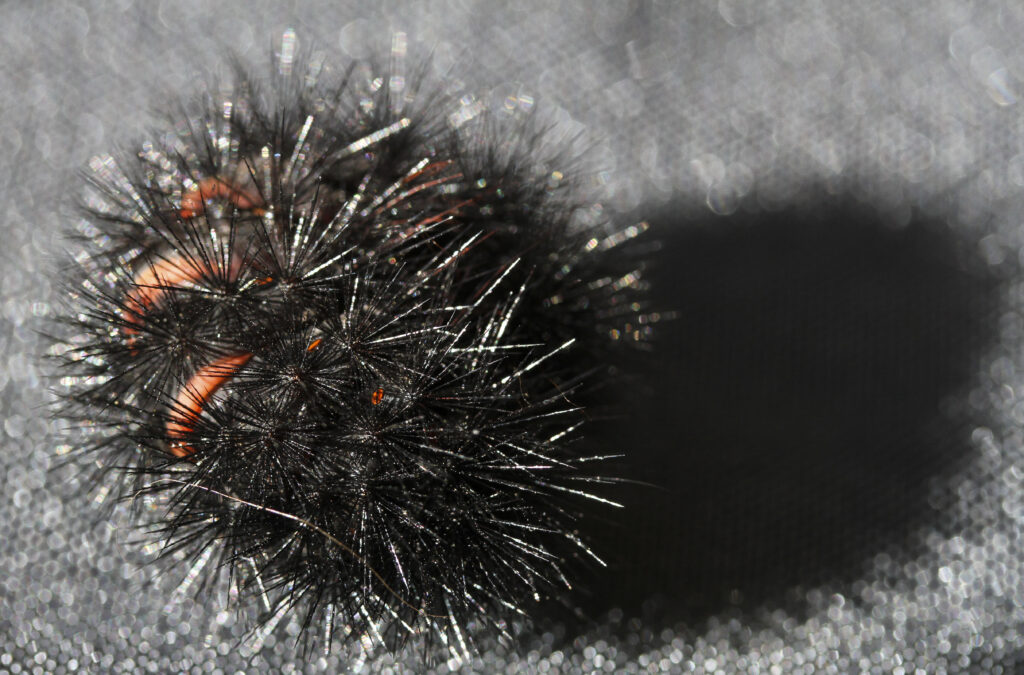Wooly Bears on the Move

By Wayne Bierbaum
A young boy was reluctant to touch the fuzzy black and brown caterpillar, let alone let it crawl over his hand. I agreed with him—almost all fuzzy caterpillars can cause a rash and some are venomous. His caution was noted, but he didn’t need to fear the species we were looking at. It was a harmless wooly bear caterpillar. An interesting bug indeed.
In late October, these caterpillars migrate in search of the perfect spot to spend the winter. During this time of travel, wooly bear caterpillars can be seen crossing roads, crawling along the edge of a house, or just traveling with purpose over a lawn. I saw more than 30 crossing a two-block section of county road in southern Anne Arundel County. Eventually, they find a place to spend the winter; under a rock or log, in a pile of leaves or any other place that protects them from the elements.
They are one of the few caterpillars that do not spend the winter as a chrysalis. A Hamilton College article describes the unique metabolic process these caterpillars use to survive winter. Before they settle for the winter, most free water is evacuated from their body and then they fill their body with an “antifreeze”. Even though they can freeze solid, this natural antifreeze stops ice crystals from rupturing and damaging their cells. “Glycogen stores are converted to glycerol and sorbitol (alcohols) which then make up 5 percent of the insect’s body mass,” stated the article. This cold weather protection process allows wooly bear caterpillars to live as far north as the Arctic Circle.
In the warming spring, the caterpillars thaw, and then, without eating, they change into a cocooned chrysalis which is covered by the caterpillar’s spines. After completing a transformation in the hard-shelled chrysalis, wooly bear caterpillars will emerge as Isabella tiger moths. The moth will live less than two weeks; during that time, it will drink a little flower nectar, mate, and lay eggs (if it is female).
Even though the wooly bears seem to be everywhere, the tiger moths are fairly hard to find. I think it is because of their short life span combined with being nocturnal, hiding during the day, and flying at night. Sometimes they are attracted to lights at night which is the best way to find them.
After they hatch, the wooly bear caterpillars are not particular about what plant they eat. The list of plants to dine on is very long, from clover to oak.
As the caterpillar goes through several growth cycles it will shed and regrow the protective segmented spine covering. Initially, the caterpillar’s spines are all black but the more times it sheds the old covering, the more reddish brown spine segments replace the black. The red color replacement usually starts in the middle of the bug and over successive sheds spreads in both directions.
The winter folklore says that the more colored segments a wooly bear has, the milder the winter will be. That postulate has been studied several times and no correlation has been found. For what it’s worth, the caterpillars I saw this fall had a large amount of brown on them.
The colored bands were more brown than red and I remember that the wooly bears I saw in Rhode Island had bright red bands around their middle. The color may be determined by what they eat or perhaps this was a subspecies.
The colored spines are actually defensive devices. When the caterpillar is threatened, it will curl into a circle, protecting its soft parts and presenting only the spines to the attacker. The length of the spines is just long enough to foil the most frequent attackers: wasps and hornets. Although I have seen a blue jay pull apart a wooly bear caterpillar, the defensive spines are usually good enough to prevent birds from making them a meal. For us, the spines are sharp enough to penetrate the skin, so I do not squeeze them or step on them with bare feet.
If they are handled gently, you can avoid being stung or stabbed. However, they frequently will ‘poop’ on you.
The wooly bear caterpillar is one of those ubiquitous animals that are often ignored but are interesting and unique. Who knew an animal could convert starch into antifreeze, yet still freeze to the point of having no bodily functions only to wake up in the spring? It would be a plus if they could also predict the weather but we can still hope that nearly all-brown caterpillars mean something.
